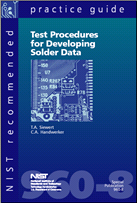Materials
for Microelectronics
Solder and Solderability
Measurements for Microelectronics
Solder and solderability are increasingly tenuous
links in the assembly of the microelectronics as a consequence
of ever shrinking chip and package dimensions and the movement
toward environmentally friendly lead-free solders. We are providing
the microelectronics industry with measurement tools and data
to address solder issues. A thermodynamic database has been publicly
distributed for modeling lead-free solder systems. We also work
closely with industry groups on measurement tools needed for development
of lead-free solders for use in harsh environments, and provide
guidance for adoption of these solders into assembly processes
through work with industrial standards organizations.
The U.S. microelectronics industry has clearly articulated
the measurement needs for lead-free solders and for solderability
and assembly. For example, the urgency for materials data for
lead-free solders has been specified in the 1997 IPC, 1999 International
Technology Roadmap for Semiconductors, 2000 and 2002 National
Electronics Manufacturing Initiative (NEMI), and 2000 IPC Lead-Free
Roadmaps. The pressure from the Japanese consumer product market
and from the European Union to produce lead-free microelectronics
continues to increase. In addition, the lack of understanding
and control of current standard solderability measurements has
inhibited the development of improved measurements necessary for
new solders and for new packaging schemes. These industrial needs
are addresses under various NIST projects, and summaries of the
extent of the work can be found below: |


